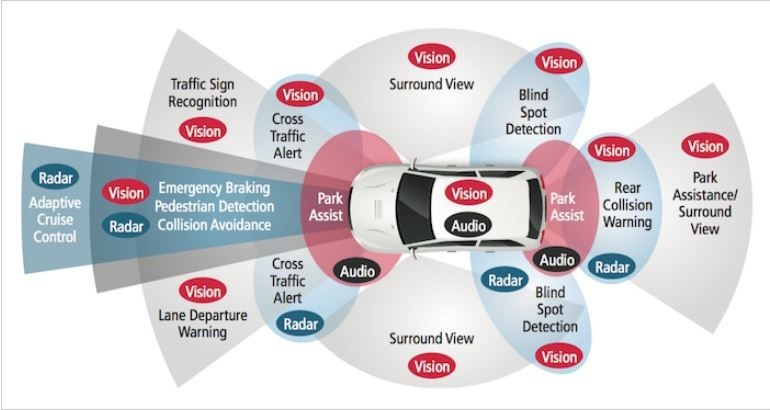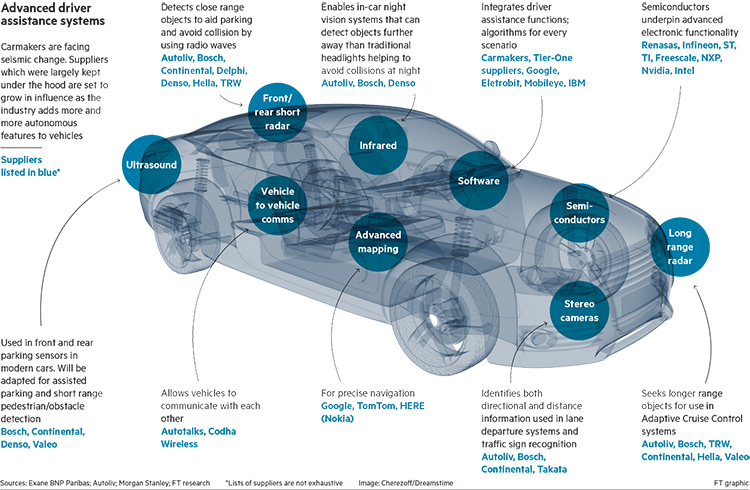By David Browne
This is the third in an INROADS series on Automated Driving Systems (ADS), renamed henceforth in this series (from “Autonomous Vehicles / AVs”) to align with recent DOT/NHTSA nomenclature. Each article has highlighted a specific theme or issue within the field. This third article is a general introduction to the topic of Technology and Connectivity. Future focus areas may include Mapping & Digitization, Testing & Certification, Liability & Insurance, Adoption, Safety including Cybersecurity, Law Enforcement, Economics & Infrastructure.
As a refresher, Automated Driving Systems (ADS) may be characterized by their classification relating to the level of their automation, i.e., the assumption of the current human roles by automated technologies.
SAE has defined six levels of automation (0-5) as follows (simplified):
| Level | Name | Automated System Role | Human Role |
| 0 | No Automation | None | All driving functions |
| 1 | Driver Assistance | Driver-assist features including adaptive cruise control, preemptive braking, lane centering, parking assist, driver observation & alerts | Responsible for all core driving functions |
| 2 | Partial Automation | Partial driving automation, e.g., steering, acceleration, deceleration | Responsible for monitoring roadway environment, ready to assume control w/ or w/o system warning |
| 3 | Conditional Automation | Most driving functions and roadway monitoring are automated. System-designated request for human intervention, driver necessity | State of ongoing readiness to assume control and intervene in response to system request |
| 4 | High Automation | All driving and monitoring functions are automated. Operation limited to selective environments, e.g., defined shuttle routes | Human control unnecessary. Steering, pedals, and gear shifting generally unavailable |
| 5 | Full Automation | All driving functions and environments without a human driver | Human input to navigation but without any vehicle control. Possible opt-in / out by human operator |
A Note on Automated Driving Systems and Safety:
A few “meta-dynamics” are worth highlighting as we frame technology and connectivity-related influences on safety, and especially on collision/injury incidence and injury severity.
Let us first consider what is likely to change most from current practice in the future environments of ADS adoption levels [recognizing that these changes will unfold both in system-wide sequential change – as automation levels are fully adopted, and in Operational Design Domains (ODDs) including localities – geographies (e.g., states), roadways / speed ranges (e.g., inner-city, classes of a highway), and particular types of more contained roadway (retirement, leisure and residential communities, universities and office parks), that may adopt heightened automation sooner or later]:
Changing Most:
1. Expectations of the Customer / User Marketplace: First, and perhaps foremost in anticipating the unfolding technical and market dynamics of ADSs let us recognize the strong evidence that consumers today expect to be injured and collectively accept much blame for collisions and injuries. Even in our highly litigious country, the vast majority of collision settlements people injured in collisions are handled via insurance, deemed caused by the party “at fault.” Most do not bring suit or seek legal settlement against manufacturers or safety equipment suppliers. In the ADS environment of the future, this may change dramatically. Consumer research conducted by ToughLove Corp. (disclosure, the company lead by the author) indicates that advocacy by consumers is far lower today in the auto industry than many other industries, largely attributable to a) consumer “resignation” to the inevitability of injury in high-speed collisions, b) crash cycle times in the milliseconds rendering them invisible to the human eye, and c) technical thresholds of physics, geometry, and biomechanical engineering knowledge exceeding laypersons level of understanding.
a. Implication – Consumers are extremely likely to expect not only dramatically fewer collisions but also far less severe injuries (from lower average speed collisions). They will, therefore, be more likely to exercise activist advocacy (including more legal action against industry suppliers) at lower injury thresholds, perhaps even any injury whatsoever. Such low to zero tolerance will place heightened demands on the industry for both active and passive safety systems that must rise to this expectation.
2. Collision Incidence is anticipated to fall significantly, decreasing with adoption rates of each higher / later stage of autonomy, with estimates as high as 90% in an era of pervasive level 5 autonomy. Human error is recognized as the single largest cause of all collisions today and “a major factor in 94% of fatal crashes” (NHTSA, USDOT Automated Driving Systems 2.0). With less and less active driver intervention and the great promise of the super-human (literally) performance of ASD sensing and response systems, collisions are most likely to be caused by:
Unavoidable collisions (compelling algorithmic “forced choice”, animals leaping into the roadway, etc.), a human error introduced by other (residual level 0-3) vehicles on the road, mechanical hardware breakdowns / wear (esp. actuators, traction and stability systems and tires), sensor errors (communication and radar / infrared / ultrasound failures), software glitches (design architecture flaws, coding errors / release-update errors), and environmental factors (roadway defects, sudden severe weather, flying debris and other environmental causes).
a. Implication – Continuous improvement in ALL operating systems, old and new, core and autonomous, will be essential to fully realize the promise of human error elimination.
3. Injury Severity is also expected to fall significantly but, barring major advances in passive safety systems such as seat belts and airbags, at rates limited to those correlating with declining average speed of collisions.
a. Implication – Innovations in material science (effective and cost-effective crumpling and cabin containment at new target speed ranges), passive safety systems design, and internal cabin environment design – – in which occupants may be standing or seated in a wide variety of positions, must all be developed.
Autonomous Technology
The technological “Building Blocks of Autonomy” (per Vision Systems Intelligence) include:
| · Development Tools | · Processing |
| · Sensors (Vision, Radar, Ultrasound) | · Connectivity |
| · Mapping and simultaneous localization (“SLAM”) | · Algorithms |
| · Security / Safety | · Autonomy Solutions (“Branded” vehicle integrators). |
As vehicles become more connected and intelligent they must communicate not only on an integrated basis within their own complex vehicle systems but also with an external environment that includes other vehicles (V2V, vehicle to vehicle), traffic patterns/signs, roadways, weather conditions, pedestrians, cyclists, etc.
An overview of “ADAS” – Advanced Driver Assistance Systems – including sensors, functions, and selective technology suppliers, is provided in the two graphics below:
Advanced Driver Assistance Systems – Sensors and Functions:


A novel aftermarket approach to autonomy is currently being developed as a robot chauffer – “IVO”:
The DRIVING ROBOT (e.g., IVO, Intelligent Vehicle Operator – or Aftermarket Self-Driving)
The “IVO” is a driving robot developed in the UK, with Israeli technology, that can be placed in the driver’s seat of any vehicle and control it. Beta testing is scheduled for completion this month, with commercial development ahead. The driving robot integrates cameras, motion sensors, and mechanical devices to direct the speed and direction of a vehicle. The intention of the IVO is for a highly portable, easily installed “kit” which can turn any vehicle autonomous.
For a glossary of ADS Terms / Acronyms, click here.
In the next edition of INROADS, we will address the development of self-driving taxis, buses and “mobility as a service.”
